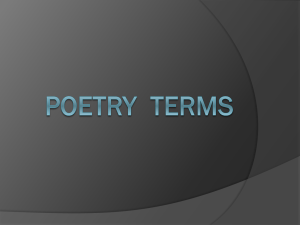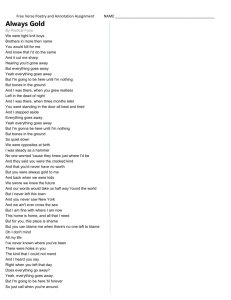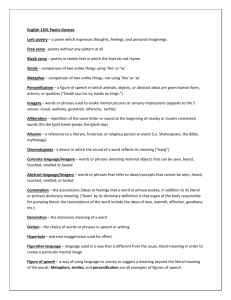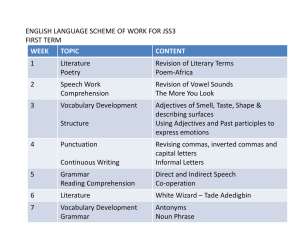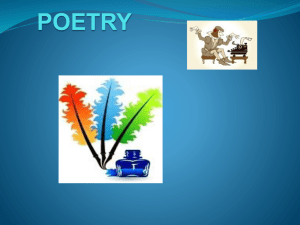249022_Vocabulary_definitions
advertisement
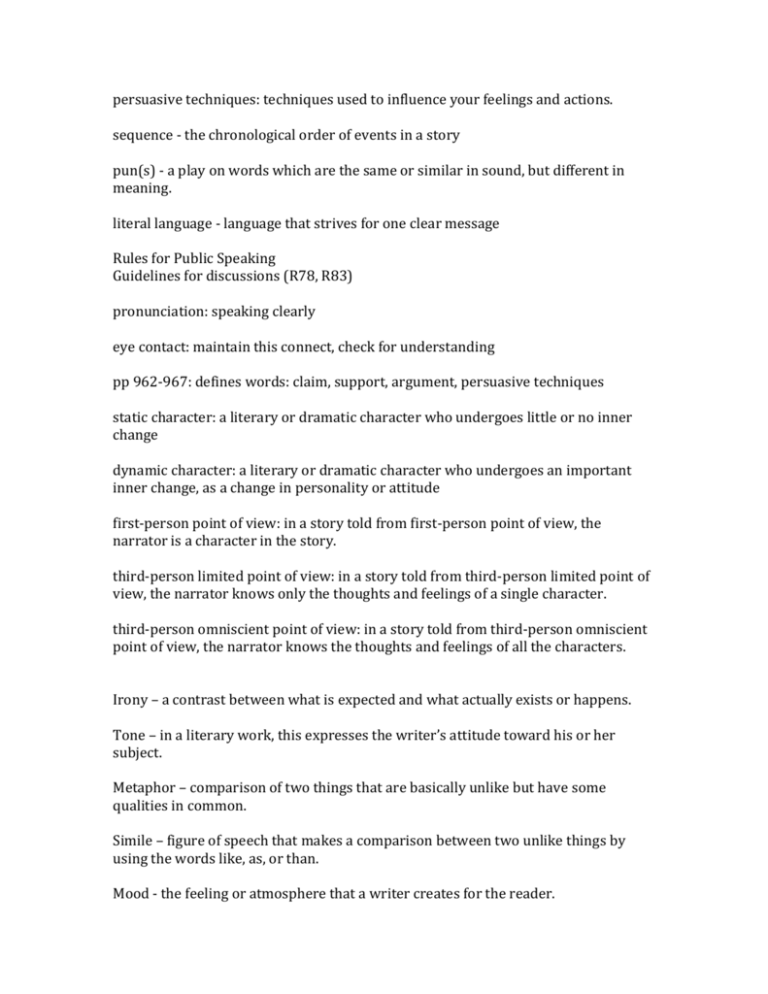
persuasive techniques: techniques used to influence your feelings and actions. sequence - the chronological order of events in a story pun(s) - a play on words which are the same or similar in sound, but different in meaning. literal language - language that strives for one clear message Rules for Public Speaking Guidelines for discussions (R78, R83) pronunciation: speaking clearly eye contact: maintain this connect, check for understanding pp 962-967: defines words: claim, support, argument, persuasive techniques static character: a literary or dramatic character who undergoes little or no inner change dynamic character: a literary or dramatic character who undergoes an important inner change, as a change in personality or attitude first-person point of view: in a story told from first-person point of view, the narrator is a character in the story. third-person limited point of view: in a story told from third-person limited point of view, the narrator knows only the thoughts and feelings of a single character. third-person omniscient point of view: in a story told from third-person omniscient point of view, the narrator knows the thoughts and feelings of all the characters. Irony – a contrast between what is expected and what actually exists or happens. Tone – in a literary work, this expresses the writer’s attitude toward his or her subject. Metaphor – comparison of two things that are basically unlike but have some qualities in common. Simile – figure of speech that makes a comparison between two unlike things by using the words like, as, or than. Mood - the feeling or atmosphere that a writer creates for the reader. Elegy – a poem of serious reflection, typically a lament for the dead. Style – Manner of expression; how a speaker or writer says what he or she says Historical context – the political, social, cultural, and economic environment related to historical moments, events, and trends. Historical Fiction – Historical fiction is a literary genre that takes place in the past. The setting is drawn from history, and often contains historical persons. Writers of stories in this genre work to portray the manners and social conditions of the persons or time(s) presented in the story, with attention paid to period detail. Sound Devices – also known as musical devices, these are elements of literature and poetry that emphasize sound. Repetition – a technique in which a sound, word, phrase, or line is repeated for emphasis or unity. Voice – a writer’s unique use of language that allows a reader to “hear” a human personality in the writer’s work. Claim – a take on something an assertion of something as a fact Opposition – one person’s side a person or group of people opposing, criticizing, or protesting something, someone, or another group. Transition – a passage from one sentence to another Supporting Detail – something that helps you to better understand the main idea Artistic License – an artist’s right to break normal rules Also, the freedom to create an artwork, musical work, or piece of writing based on the artist's interpretation and mainly for effect; also called poetic license, etc. Artistic license often provokes controversy by offending those who resent the reinterpretation of cherished beliefs or previous works. (Poetic license: license or liberty taken by a poet, prose writer, or other artist in deviating from rule, conventional form, logic, or fact, in order to produce a desired effect.) Verbals – words that are formed from verbs and that act as nouns, adjectives, or adverbs. Infinitives – a verb form that usually begins with the word to and acts as a noun, an adjective, or an adverb. Gerunds – a verbal that ends in -ing and acts as a noun. Participles – a verb form that acts as an adjective. ballad a poem or song narrating a story in short stanzas. conventions include spelling, punctuation, capitalization, grammar, and paragraph organization figurative language words being used in a imaginative way to express ideas that are not literally true. This is used for comparison, emphasis, and emotional effect. formal voice used in formal writing and when writing to a person or group of people with whom you are unfamiliar and whom you consider to be superior in rank. informal voice less professional than formal voice, this is casual language, comfortable language that is used in communications with family, friends and peers. passage a portion or section of a written work; a paragraph, verse, etc. rhyme This is the correspondence of sound between words or the endings of words, especially when these are used at the ends of lines of poetry. rhythm This is a pattern of stresses and unstressed syllables in a line of poetry. Poets used this to bring out the musical quality of language, to emphasize ideas, and to create moods. sound devices Also known as musical devices, these are elements of literature and poetry that emphasize sound. symbolism Use of an object that stands for something larger than itself, usually an abstract concept. irony This is the contrast between what is expected and what actually exists or happens. metaphor This is a comparison of two things that are basically unlike but have some qualities in common. simile This is a figure of speech that makes a comparison between two unlike things by using the words like, as, or than. repetition This is a technique in which a sound, word, phrase, or line is repeated for emphasis or unity. elegy This is a poem of serious reflection, typically a lament for the dead. This poem reflects on death, or mourns the loss of someone or something. dialect/local color This is a particular form of a language that is peculiar to a specific region or social group. literary devices literary terms; tools and techniques of language that authors use to convey meaning. Using them skillfully brings richness and clarity to a text. onomatopoeia words that sound like what they mean alliteration the repetition of initial consonant sounds, creating memorable and moving lines hyperbole overstatement, exaggeration used for humor or emphasis description writing that helps a reader to picture events, objects, and characters; often using imagery imagery/sensory details the use of vivid language to convey sensations that helps us to experience fully what we read; words and phrases that appeal to the reader's senses dialogue actual conversation in a written piece, bringing vitality and credibility to poetry. author's purpose author's intent; his or her reason for writing assonance This is the repetition of vowel sounds when consonant sounds are unlike creating partial rhyme. consonance repeated consonant sounds (not at the beginning of the word) traditional verse contains a strict verse pattern, regular rhyme, very structured poetry free verse This type of poetry lets the writer use language that appeals to the head and the heart, and doesn't follow a strict verse pattern or require rhyming. It is imaginative and fun. line the core unit of a poem form the structure or organization of a work of writing; the arrangement of words and lines on a page stanza a group of two or more lines that form a unit in a poem meter a regular pattern of stressed and unstressed syllables in a poem which emphasizes the musical quality of the language personification the giving of human characteristics to an animal, object, or idea lyric poetry personal, subjective poems that appeal to our senses and emotions, and that can rhyme or be in free verse narrative poetry poems that tell a story or recount events ode a lyric poem of a serious or meditative nature that aims to elevate its subject ballad a poem or song narrating a story in short stanzas. conventions include spelling, punctuation, capitalization, grammar, and paragraph organization figurative language words being used in a imaginative way to express ideas that are not literally true. This is used for comparision, emphasis, and emotional effect. formal voice used in formal writing and when writing to a person or group of people with whom you are unfamiliar and whom you consider to be superior in rank. informal voice less professional than formal voice, this is casual language, comfortable language that is used in communications with family, friends and peers. passage a portion or section of a written work; a paragraph, verse, etc. rhyme This is the correspondence of sound between words or the endings of words, especially when these are used at the ends of lines of poetry. rhythm This is a pattern of stresses and unstressed syllables in a line of poetry. Poets used this to bring out the musical quality of language, to emphasize ideas, and to create moods. sound devices Also known as musical devices, these are elements of literature and poetry that emphasize sound. symbolism Use of an object that stands for something larger than itself, usually an abstract concept. irony This is the contrast between what is expected and what actually exists or happens. metaphor This is a comparison of two things that are basically unlike but have some qualities in common. simile This is a figure of speech that makes a comparison between two unlike things by using the words like, as, or than. repetition This is a technique in which a sound, word, phrase, or line is repeated for emphasis or unity. elegy This is a poem of serious reflection, typically a lament for the dead. This poem reflects on death, or mourns the loss of someone or something. dialect/local color This is a particular form of a language that is peculiar to a specific region or social group. literary devices literary terms; tools and techniques of language that authors use to convey meaning. Using them skillfully brings richness and clarity to a text. onomatopoeia words that sound like what they mean alliteration the repetition of initial consonant sounds, creating memorable and moving lines hyperbole overstatement, exaggeration used for humor or emphasis description writing that helps a reader to picture events, objects, and characters; often using imagery imagery/sensory details the use of vivid language to convey sensations that helps us to experience fully what we read; words and phrases that appeal to the reader's senses dialogue actual conversation in a written piece, bringing vitality and credibility to poetry. author's purpose author's intent; his or her reason for writing assonance This is the repetition of vowel sounds when consonant sounds are unlike creating partial rhyme. consonance repeated consonant sounds (not at the beginning of the word) traditional verse contains a strict verse pattern, regular rhyme, very structured poetry free verse This type of poetry lets the writer use language that appeals to the head and the heart, and doesn't follow a strict verse pattern or require rhyming. It is imaginative and fun. line the core unit of a poem form the structure or organization of a work of writing; the arrangement of words and lines on a page stanza a group of two or more lines that form a unit in a poem meter a regular pattern of stressed and unstressed syllables in a poem which emphasizes the musical quality of the language personification the giving of human characteristics to an animal, object, or idea lyric poetry personal, subjective poems that appeal to our senses and emotions, and that can rhyme or be in free verse narrative poetry poems that tell a story or recount events ode a lyric poem of a serious or meditative nature that aims to elevate its subject Theme: The theme is the main point, message, or lesson in a piece of writing. Character: a character is a person, animal or imaginary being who takes part in the action of a work of literature Setting: the setting of a story, poem, or play is the time and place of the action. Symbol: object, character, figure or color used to represent an abstract idea or concept. Conflict: a struggle between opposing forces. Most stories have a main conflict that is the story's focus.

